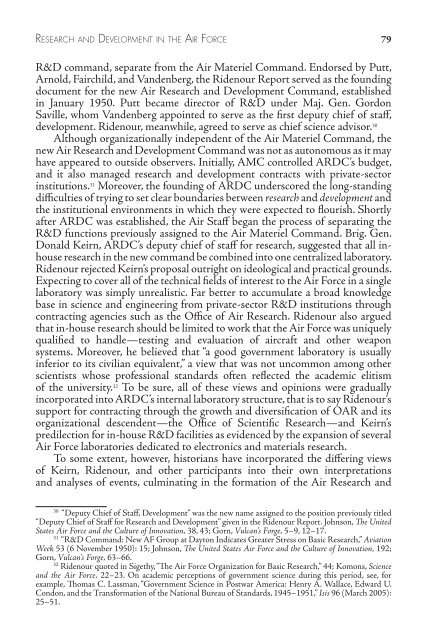To download as a PDF click here - US Army Center Of Military History
To download as a PDF click here - US Army Center Of Military History
To download as a PDF click here - US Army Center Of Military History
Create successful ePaper yourself
Turn your PDF publications into a flip-book with our unique Google optimized e-Paper software.
ReseaRch a n d developmenT In T h e aIR fo R c e 79<br />
R&D command, separate from the Air Materiel Command. Endorsed by Putt,<br />
Arnold, Fairchild, and Vandenberg, the Ridenour Report served <strong>as</strong> the founding<br />
document for the new Air Research and Development Command, established<br />
in January 1950. Putt became director of R&D under Maj. Gen. Gordon<br />
Saville, whom Vandenberg appointed to serve <strong>as</strong> the first deputy chief of staff,<br />
development. Ridenour, meanwhile, agreed to serve <strong>as</strong> chief science advisor. 30<br />
Although organizationally independent of the Air Materiel Command, the<br />
new Air Research and Development Command w<strong>as</strong> not <strong>as</strong> autonomous <strong>as</strong> it may<br />
have appeared to outside observers. Initially, AMC controlled ARDC’s budget,<br />
and it also managed research and development contracts with private-sector<br />
institutions. 31 Moreover, the founding of ARDC underscored the long-standing<br />
difficulties of trying to set clear boundaries between research and development and<br />
the institutional environments in which they were expected to flourish. Shortly<br />
after ARDC w<strong>as</strong> established, the Air Staff began the process of separating the<br />
R&D functions previously <strong>as</strong>signed to the Air Materiel Command. Brig. Gen.<br />
Donald Keirn, ARDC’s deputy chief of staff for research, suggested that all inhouse<br />
research in the new command be combined into one centralized laboratory.<br />
Ridenour rejected Keirn’s proposal outright on ideological and practical grounds.<br />
Expecting to cover all of the technical fields of interest to the Air Force in a single<br />
laboratory w<strong>as</strong> simply unrealistic. Far better to accumulate a broad knowledge<br />
b<strong>as</strong>e in science and engineering from private-sector R&D institutions through<br />
contracting agencies such <strong>as</strong> the <strong>Of</strong>fice of Air Research. Ridenour also argued<br />
that in-house research should be limited to work that the Air Force w<strong>as</strong> uniquely<br />
qualified to handle—testing and evaluation of aircraft and other weapon<br />
systems. Moreover, he believed that “a good government laboratory is usually<br />
inferior to its civilian equivalent,” a view that w<strong>as</strong> not uncommon among other<br />
scientists whose professional standards often reflected the academic elitism<br />
of the university. 32 <strong>To</strong> be sure, all of these views and opinions were gradually<br />
incorporated into ARDC’s internal laboratory structure, that is to say Ridenour’s<br />
support for contracting through the growth and diversification of OAR and its<br />
organizational descendent—the <strong>Of</strong>fice of Scientific Research—and Keirn’s<br />
predilection for in-house R&D facilities <strong>as</strong> evidenced by the expansion of several<br />
Air Force laboratories dedicated to electronics and materials research.<br />
<strong>To</strong> some extent, however, historians have incorporated the differing views<br />
of Keirn, Ridenour, and other participants into their own interpretations<br />
and analyses of events, culminating in the formation of the Air Research and<br />
30 “Deputy Chief of Staff, Development” w<strong>as</strong> the new name <strong>as</strong>signed to the position previously titled<br />
“Deputy Chief of Staff for Research and Development” given in the Ridenour Report. Johnson, The United<br />
States Air Force and the Culture of Innovation, 38, 43; Gorn, Vulcan’s Forge, 5–9, 12–17.<br />
31 “R&D Command: New AF Group at Dayton Indicates Greater Stress on B<strong>as</strong>ic Research,” Aviation<br />
Week 53 (6 November 1950): 15; Johnson, The United States Air Force and the Culture of Innovation, 192;<br />
Gorn, Vulcan’s Forge, 63–66.<br />
32 Ridenour quoted in Sigethy, “The Air Force Organization for B<strong>as</strong>ic Research,” 44; Komons, Science<br />
and the Air Force, 22–23. On academic perceptions of government science during this period, see, for<br />
example, Thom<strong>as</strong> C. L<strong>as</strong>sman, “Government Science in Postwar America: Henry A. Wallace, Edward U.<br />
Condon, and the Transformation of the National Bureau of Standards, 1945–1951,” Isis 96 (March 2005):<br />
25–51.

















